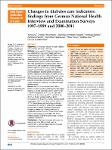Changes in diabetes care indicators: findings from German National Health Interview and Examination Surveys 1997–1999 and 2008–2011
Du, Yong
Heidemann, Christin
Rosario, Angelika Schaffrath
Buttery, Amanda
Paprott, Rebecca
Neuhauser, Hannelore
Riedel, Thea
Icks, Andrea
Scheidt-Nave, Christa
Objectives: To investigate changes in type 2 diabetes care indicators over time in Germany. Methods: Adults aged 45–79 years with type 2 diabetes were identified from two national health examination surveys conducted in 1997–1999 (GNHIES98, n=333) and in 2008–2011 (DEGS1, n=526). We examined diabetes care indicators including treatment and preventive targets (glycemic control, blood pressure (BP), total cholesterol (TC), smoking, weight reduction, sports activity), self-management and care process measures (glucose self-monitoring, holding a diabetes passport, annual foot and eye examination; statin use), and the presence of diabetes-specific complications (diabetic nephropathy, retinopathy, neuropathy, diabetic foot, amputations) and comorbid cardiovascular disease (CVD) or chronic kidney disease (CKD). We calculated proportions of persons meeting these care indicators by survey and examined unadjusted and adjusted changes between surveys. Results: Significant improvement (GNHIES98 vs DEGS1) over time was observed for glycated hemoglobin (HbA1c)
No license information

